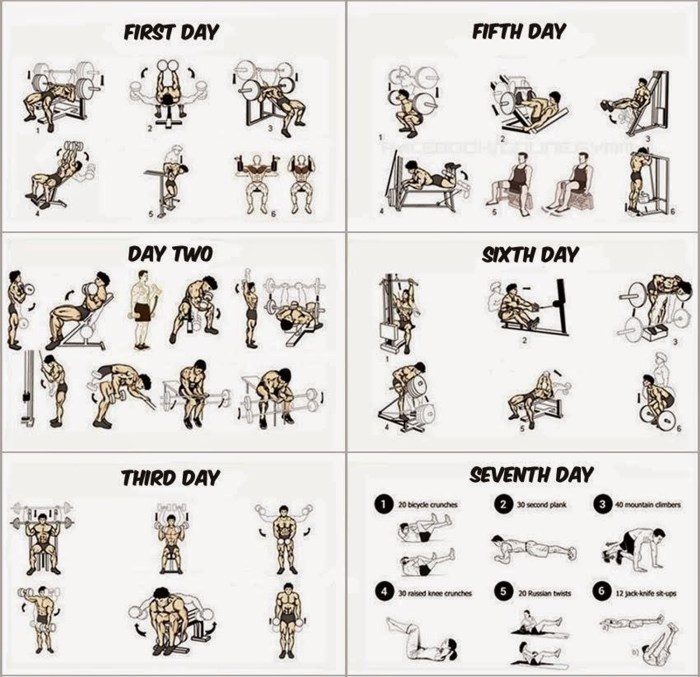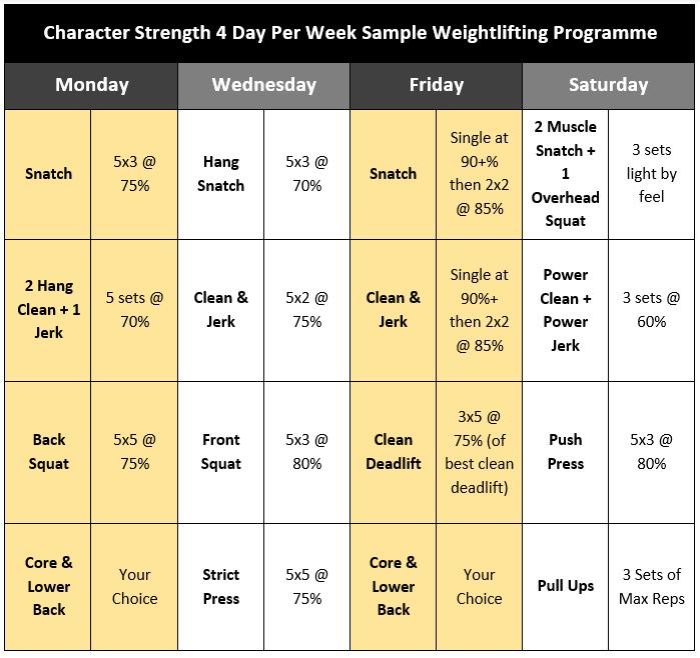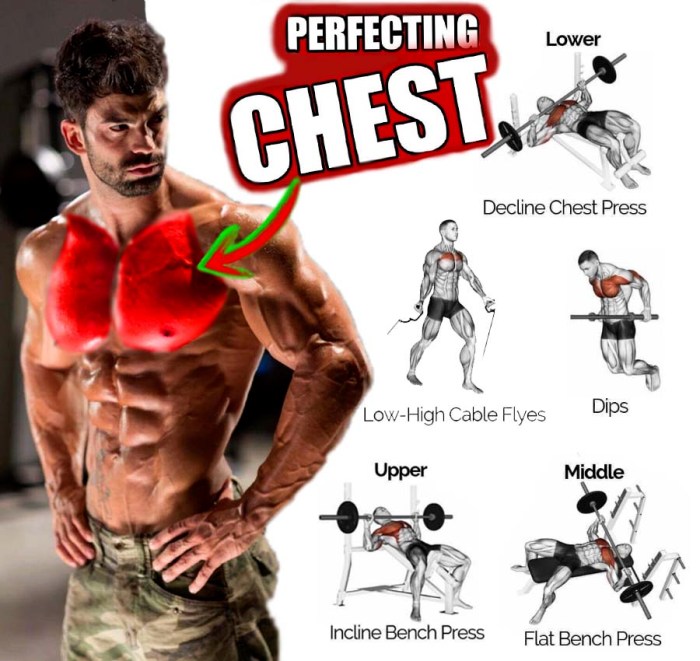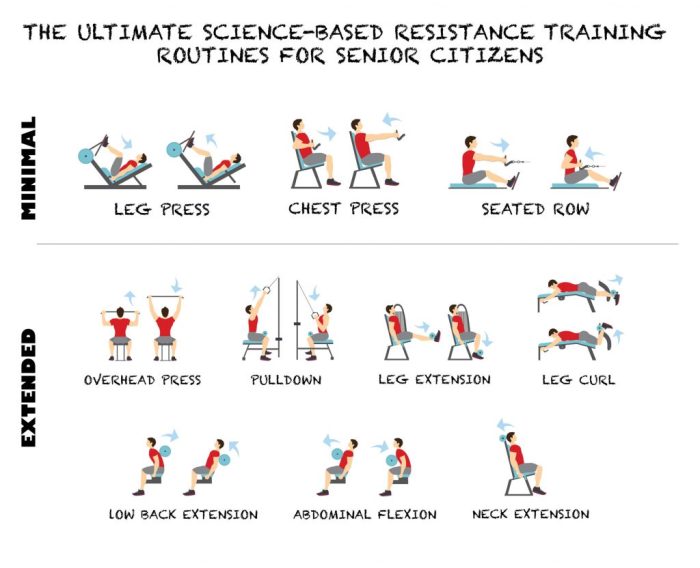Introducing the training program for mass and strength, your ultimate guide to achieving your fitness goals. Whether you’re a seasoned athlete or just starting out, this program will provide you with the knowledge and tools you need to build muscle, increase strength, and transform your body.
Throughout this comprehensive program, we’ll delve into the scientific principles of muscle growth and strength development, providing you with a deep understanding of how your body responds to exercise. We’ll cover everything from exercise selection and proper technique to nutrition, recovery, and injury prevention.
Program Overview
This training program is designed to help you build muscle mass and strength. It is a progressive program that will challenge you and help you reach your fitness goals.
This program is appropriate for beginners and intermediate lifters. It is recommended that you have some experience with weightlifting before starting this program.
The program is 12 weeks long and should be performed 3-4 times per week. Each workout will take approximately 60-90 minutes to complete.
Program Goals
- Increase muscle mass
- Increase strength
- Improve body composition
- Boost metabolism
Training Principles
Understanding the scientific principles that underpin your training program is crucial for maximizing results. These principles guide the design and implementation of your workouts, ensuring they are effective, efficient, and safe.
The cornerstone of any successful training program is progressive overload. This principle states that to continually improve, you must gradually increase the stress placed on your muscles. By progressively increasing the weight you lift, the number of repetitions you perform, or the frequency of your workouts, you force your body to adapt and grow stronger.
Specificity
The principle of specificity dictates that the adaptations your body makes are specific to the exercises you perform. In other words, if you want to improve your bench press, you need to perform bench press exercises. This principle emphasizes the importance of choosing exercises that target the specific muscles and movements you want to develop.
Recovery
Recovery is an essential but often overlooked aspect of training. During recovery, your body repairs and rebuilds the muscle tissue that has been broken down during exercise. Without adequate recovery, your muscles will not be able to adapt and grow stronger.
Sufficient sleep, proper nutrition, and rest days are crucial for maximizing recovery.
Exercise Selection

Exercise selection is crucial for building mass and strength. The exercises in this program are chosen to target all major muscle groups and promote optimal muscle growth and strength gains.
Proper form and technique are essential for maximizing results and minimizing the risk of injury. Follow the instructions below for each exercise, and consult with a qualified trainer if you have any questions or need guidance.
Compound Exercises
Compound exercises involve multiple muscle groups in a single movement. They are highly effective for building mass and strength.
- Barbell Back Squat:Targets the quadriceps, glutes, hamstrings, and core. Stand with your feet shoulder-width apart, hold the barbell across your upper back, and squat down until your thighs are parallel to the floor. Push through your heels to return to the starting position.
- Bench Press:Targets the chest, shoulders, and triceps. Lie on a bench with your feet flat on the floor, hold the barbell above your chest, and lower it to your chest. Press the barbell back up to the starting position.
- Deadlift:Targets the back, glutes, hamstrings, and core. Stand with your feet hip-width apart, hold the barbell in front of your shins, and lift it off the floor by extending your hips and knees. Lower the barbell back down to the floor.
- Overhead Press:Targets the shoulders, triceps, and upper back. Stand with your feet shoulder-width apart, hold the barbell above your head, and lower it to your shoulders. Press the barbell back up to the starting position.
Isolation Exercises
Isolation exercises target specific muscle groups. They are useful for developing muscle definition and strength.
- Bicep Curls:Targets the biceps. Stand with your feet shoulder-width apart, hold a dumbbell in each hand, and curl the dumbbells up to your shoulders. Lower the dumbbells back down to the starting position.
- Triceps Extensions:Targets the triceps. Sit on a bench with your feet flat on the floor, hold a dumbbell in each hand, and extend your arms overhead. Lower the dumbbells behind your head and then extend them back up to the starting position.
- Leg Extensions:Targets the quadriceps. Sit on a leg extension machine, place your feet on the footplate, and extend your legs against the resistance. Lower your legs back down to the starting position.
- Hamstring Curls:Targets the hamstrings. Lie on a hamstring curl machine, place your feet on the footplate, and curl your legs up towards your glutes. Lower your legs back down to the starting position.
Variations
Variations of exercises can be used to accommodate different fitness levels and target different muscle groups.
- Goblet Squat:A variation of the barbell back squat that is easier for beginners and those with limited mobility.
- Dumbbell Bench Press:A variation of the barbell bench press that allows for a greater range of motion.
- Romanian Deadlift:A variation of the deadlift that targets the hamstrings more.
- Arnold Press:A variation of the overhead press that targets the shoulders from different angles.
Exercise Table
The following table summarizes the exercises, their purpose, form, variations, and target muscle groups:
| Exercise | Purpose | Form | Variations | Target Muscle Groups |
|---|---|---|---|---|
| Barbell Back Squat | Quadriceps, glutes, hamstrings, core | Squat down until thighs are parallel to the floor. | Goblet Squat | Quadriceps, glutes, hamstrings, core |
| Bench Press | Chest, shoulders, triceps | Lower barbell to chest and press back up. | Dumbbell Bench Press | Chest, shoulders, triceps |
| Deadlift | Back, glutes, hamstrings, core | Lift barbell off the floor by extending hips and knees. | Romanian Deadlift | Back, glutes, hamstrings |
| Overhead Press | Shoulders, triceps, upper back | Lower barbell to shoulders and press back up. | Arnold Press | Shoulders, triceps, upper back |
| Bicep Curls | Biceps | Curl dumbbells up to shoulders. | N/A | Biceps |
| Triceps Extensions | Triceps | Extend dumbbells behind head and back up. | N/A | Triceps |
| Leg Extensions | Quadriceps | Extend legs against resistance on machine. | N/A | Quadriceps |
| Hamstring Curls | Hamstrings | Curl legs up towards glutes on machine. | N/A | Hamstrings |
Video Demonstrations
Watch the following videos for detailed demonstrations of each exercise:
- Barbell Back Squat
- Bench Press
- Deadlift
- Overhead Press
- Bicep Curls
- Triceps Extensions
- Leg Extensions
- Hamstring Curls
Personalized Exercise Plan
Your personalized exercise plan will be based on your fitness level, goals, and limitations. Your trainer will work with you to develop a plan that is tailored to your individual needs.
Progressive Overload
Progressive overload is a key principle of strength training. It involves gradually increasing the weight, resistance, or sets and repetitions over time. This forces your muscles to adapt and grow stronger.
Set and Repetition Schemes
Determining the appropriate sets, repetitions, and rest periods is crucial for maximizing results. These parameters should be tailored to your fitness level and goals.
Fitness Level
- Beginners:2-3 sets of 10-12 repetitions with 60-90 seconds of rest between sets.
- Intermediate:3-4 sets of 8-10 repetitions with 90-120 seconds of rest between sets.
- Advanced:4-5 sets of 6-8 repetitions with 120-180 seconds of rest between sets.
Goals
- Mass:8-12 repetitions with 60-90 seconds of rest.
- Strength:6-8 repetitions with 90-120 seconds of rest.
- Power:2-5 repetitions with 120-180 seconds of rest.
Progression
To ensure continued progress, adjust these parameters gradually over time. Increase the weight, sets, or repetitions as you get stronger.
Periodization
Periodization is essential for optimizing progress. It involves cycling through different training phases with specific goals.
Types of Periodization
- Linear:Gradually increasing the weight or volume.
- Undulating:Alternating between high and low-volume training phases.
- Block:Dividing the program into specific blocks with different focuses (e.g., strength, mass, power).
Benefits of Periodization
- Prevents plateaus.
- Reduces the risk of overtraining.
- Optimizes recovery and adaptation.
Implementing Periodization
Implement periodization by varying the training variables (weight, sets, repetitions, rest) and incorporating deload weeks to allow for recovery.
Nutrition

Nutrition plays a pivotal role in supporting muscle growth and strength development. Consuming an adequate amount of calories, along with the right balance of macronutrients (protein, carbohydrates, and fat), is crucial for building and maintaining muscle mass.
Macronutrient Intake
Protein
Aim for a daily protein intake of 1.6-2.2 grams per kilogram of body weight. Protein is essential for muscle repair and growth.
Carbohydrates
Consume 4-6 grams of carbohydrates per kilogram of body weight daily. Carbohydrates provide energy for intense workouts and support muscle recovery.
Fat
Include 1-1.2 grams of fat per kilogram of body weight in your diet. Healthy fats support hormone production and provide essential fatty acids.
Hydration and Recovery Nutrition
Hydration
Drink plenty of water throughout the day, especially before, during, and after workouts. Dehydration can impair muscle function and recovery.
Post-workout Meal
Within 30-60 minutes after your workout, consume a meal rich in protein and carbohydrates. This helps replenish glycogen stores and initiate muscle repair.
Sample Meal Plan
Here’s a sample meal plan that meets the nutritional needs for muscle growth:
Breakfast
Oatmeal with fruit, nuts, and milk
Lunch
Grilled chicken salad with brown rice and vegetables
Dinner
Salmon with roasted vegetables and quinoa
Snacks
Protein shake, fruit, yogurt
Nutritional Recommendations
| Nutrient | Recommended Intake |
|---|---|
| Protein | 1.6-2.2 g/kg body weight |
| Carbohydrates | 4-6 g/kg body weight |
| Fat | 1-1.2 g/kg body weight |
| Water | Drink plenty throughout the day |
| Post-workout Meal | Protein and carbohydrates within 30-60 minutes after workout |
– Supplementation
Supplements can be a valuable addition to a mass and strength training program, but it’s important to be aware of their potential benefits and risks before using them.
Some of the potential benefits of supplements include:
- Increased muscle mass and strength
- Improved recovery from workouts
- Reduced risk of injuries
However, it’s important to be aware of the potential risks of supplements as well. Some supplements can cause side effects, such as nausea, vomiting, diarrhea, and headaches. Others can interact with medications or have long-term health effects.
It’s important to talk to your doctor before using any supplements, especially if you have any underlying health conditions or are taking any medications.
Commonly Used Supplements for Mass and Strength Training
Some of the most commonly used supplements for mass and strength training include:
- Creatine
- Protein powder
- BCAAs
- Glutamine
- Beta-alanine
These supplements work in different ways to help you build muscle and strength. Creatine, for example, helps to increase the body’s production of energy, while protein powder helps to repair and build muscle tissue.
It’s important to note that supplements are not a magic bullet. They can’t replace a healthy diet and exercise program. However, they can be a valuable addition to your training regimen, helping you to reach your goals faster.
Supplements Table
| Supplement | Benefits | Risks | Recommended Dosage |
|---|---|---|---|
| Creatine | Increased muscle mass and strength, improved recovery from workouts | Nausea, vomiting, diarrhea | 5-10 grams per day |
| Protein powder | Repair and build muscle tissue | Weight gain, digestive problems | 1.6-2.2 grams per kilogram of body weight per day |
| BCAAs | Reduced muscle soreness, improved recovery from workouts | Nausea, vomiting, diarrhea | 5-10 grams per day |
| Glutamine | Reduced muscle soreness, improved recovery from workouts | Nausea, vomiting, diarrhea | 5-10 grams per day |
| Beta-alanine | Improved muscular endurance | Tingling sensation in the skin | 2-5 grams per day |
Resources
There are a number of resources available where you can find more information on supplements.
Recovery and Regeneration

Adequate rest and recovery are crucial for muscle growth and repair. During exercise, muscle fibers are damaged, and recovery allows them to repair and rebuild, leading to increased strength and size.
Several techniques promote recovery, including:
Sleep
Sleep is essential for muscle recovery. During sleep, the body releases hormones that promote muscle growth and repair. Aim for 7-9 hours of quality sleep each night.
Stretching
Stretching helps improve flexibility and range of motion, reducing muscle soreness and promoting blood flow to muscles. Incorporate stretching into your warm-up and cool-down routines.
Foam Rolling
Foam rolling is a self-massage technique that helps release muscle tension and improve blood flow. Use a foam roller to target tight muscles after workouts.
Training Intensity and Volume Management
Managing training intensity and volume is crucial for optimizing recovery. Avoid overtraining by gradually increasing training intensity and volume over time. Listen to your body and take rest days when needed.
Monitoring Progress
Tracking your progress is crucial for assessing your progress, making adjustments, and staying motivated. Here are effective methods for monitoring your progress.
Weight Measurements
Regularly weighing yourself provides a simple and straightforward way to track changes in body mass. However, it’s important to note that weight measurements alone do not provide detailed information about body composition.
Body Composition Analysis
Body composition analysis techniques, such as bioelectrical impedance analysis (BIA) or dual-energy X-ray absorptiometry (DEXA), offer a more comprehensive assessment of body composition, including muscle mass, fat mass, and hydration levels.
Performance Tests
Assessing your performance in exercises relevant to your goals, such as bench press or squat, provides valuable insights into your strength and progress over time.
Regular Assessments and Adjustments
Regularly assessing your progress allows you to identify areas where adjustments may be necessary. For example, if your weight is not increasing as expected, you may need to adjust your calorie intake or training intensity.
Technology and Progress Monitoring
Fitness trackers and other wearable devices can provide valuable data on your activity levels, sleep patterns, and other metrics that can contribute to your progress monitoring.
Injury Prevention

Injury prevention is paramount in mass and strength training. Common injuries include muscular strains, ligament sprains, tendon tears, and joint pain. Preventing these injuries requires a comprehensive approach that incorporates proper warm-up and cool-down, using correct form and technique, lifting weights appropriate for your fitness level, and listening to your body’s cues for rest.
Gradual Progression
Gradual progression is crucial to avoid overloading your body and increasing the risk of injury. Start with a manageable weight and gradually increase it as you grow stronger. Avoid sudden jumps in weight or intensity, as this can put excessive stress on your muscles, tendons, and joints.
Recovery and Nutrition
Adequate recovery and nutrition are essential for injury prevention. Ensure you get enough rest between workouts to allow your muscles and connective tissues to repair and rebuild. A balanced diet rich in protein, carbohydrates, and healthy fats supports muscle recovery and reduces the risk of nutrient deficiencies that can contribute to injuries.
Seeking Professional Advice
If you experience any pain or discomfort during training, it’s important to seek professional advice from a qualified healthcare practitioner or physical therapist. They can assess the issue, provide appropriate treatment, and recommend modifications to your training program to minimize the risk of further injury.
Training Environment

Your training environment plays a crucial role in your success in mass and strength training. It should provide you with the space, equipment, and support you need to reach your goals.
Space
Choose a training space that is large enough to perform all your exercises without obstruction. You should have enough room to move around freely and safely, even when using heavy weights.
Equipment
Access to appropriate equipment is essential for mass and strength training. This includes barbells, dumbbells, weightlifting platforms, and resistance bands. Choose a gym or training facility that has the equipment you need, and make sure it is in good condition.
Accessibility
Convenience is key. Choose a training environment that is easily accessible and has flexible hours. This will make it easier for you to stick to your training schedule.
Support
Having a supportive training environment can make a big difference in your motivation and progress. Consider training with a partner, coach, or in a group setting. Surrounding yourself with people who are also working towards their fitness goals can provide encouragement and accountability.
Motivation
Creating a motivating training environment can help you stay focused and push yourself harder. Use music, positive affirmations, or a visually stimulating environment to keep you energized and motivated.
Training Partners and Support
Training with a partner or group can provide numerous benefits, including increased motivation, accountability, and safety. Finding a support system of friends, family, or colleagues who encourage and motivate you is crucial for staying on track with your fitness goals.
Finding Training Partners
* Reach out to friends, family, or colleagues who share similar fitness goals.
- Join a gym or fitness class where you can meet like-minded individuals.
- Use social media or online forums to connect with potential training partners.
Qualities of a Good Training Partner
* Similar fitness goals and workout schedule
- Positive and encouraging attitude
- Reliable and committed
- Willing to push you and hold you accountable
Benefits of Training with a Partner vs. Training Alone, Training program for mass and strength
| Feature | Training with a Partner | Training Alone ||—|—|—|| Motivation | Higher | Lower || Accountability | Higher | Lower || Safety | Higher | Lower || Encouragement | Higher | Lower || Competition | Can be motivating | Can be demotivating || Cost | Can be shared | Higher |
Building a Support System
* Surround yourself with positive and supportive people.
- Share your fitness goals with friends and family and ask for their encouragement.
- Join support groups or online communities related to your fitness goals.
Resources for Finding Support Groups
* Meetup.com
- Facebook groups
- Local gyms and fitness centers
- Online forums and message boards
Mindset and Motivation: Training Program For Mass And Strength

Mindset and motivation are critical components for achieving any goal, including fitness goals. Having a positive mindset and staying motivated will help you overcome setbacks, stay consistent with your training, and ultimately achieve your desired results.
Goal Setting and Visualization
Setting specific, achievable goals will give you something to strive for and help you stay motivated. Visualizing yourself achieving your goals can also help to keep you focused and inspired. When you visualize yourself completing a difficult workout or reaching a new milestone, it can help to boost your confidence and make the goal seem more attainable.
Overcoming Setbacks
Everyone experiences setbacks from time to time. The key is to not let setbacks derail you. If you miss a workout or don’t see the results you want as quickly as you hoped, don’t give up. Learn from your mistakes and adjust your plan as needed.
Remember that progress is not always linear, and there will be ups and downs along the way.
Staying Motivated
Staying motivated can be difficult at times, especially when you’re tired or feeling discouraged. There are a few things you can do to stay motivated, such as:
- Find a training partner or group to support you.
- Set realistic goals and celebrate your progress along the way.
- Reward yourself for reaching milestones.
- Focus on the benefits of exercise, such as improved health and fitness.
- Remember why you started training in the first place.
Sample Training Plan
Here’s a sample training plan to provide you with a structured approach to your mass and strength training journey. This plan includes exercises, sets, repetitions, and rest periods for a week or two, along with a progression plan to demonstrate how the program can be adjusted over time.
Additionally, we’ll provide guidance on modifying the plan based on your individual fitness levels and goals.
Week 1-2
- Monday:Barbell Back Squat, Leg Press, Hamstring Curls, Calf Raises
- Tuesday:Bench Press, Dumbbell Flyes, Triceps Pushdowns, Lateral Raises
- Wednesday:Rest
- Thursday:Deadlift, Romanian Deadlifts, Bicep Curls, Overhead Triceps Extensions
- Friday:Incline Dumbbell Press, Shoulder Press, Lateral Raises, Skullcrushers
- Saturday:Rest
- Sunday:Rest
For each exercise, perform 3-4 sets of 8-12 repetitions with 60-90 seconds of rest between sets.
Progression
As you progress, you can increase the weight you lift, the number of sets or repetitions, or the frequency of your workouts. For example, you could add 5-10 pounds to your barbell back squat every week, or you could add an extra set of bicep curls to your Thursday workout.
Individualization
This is just a sample training plan, so you may need to modify it based on your individual fitness levels and goals. If you’re new to strength training, you may want to start with lighter weights and fewer sets. If you’re more experienced, you may want to lift heavier weights and do more sets.
Success Stories and Testimonials
Witness the incredible transformations achieved by individuals who embraced this program. Their success stories serve as a testament to its effectiveness.
We’ve compiled before-and-after photos and videos that showcase the remarkable results our clients have achieved. These visual representations provide tangible evidence of the program’s ability to build muscle mass and increase strength.
Factors Contributing to Success
- Adherence to the training plan and exercise protocols
- Consistent nutrition and supplementation
- Adequate rest and recovery
- Strong mindset and unwavering motivation
- Support from training partners and coaches
Final Conclusion
By following the principles Artikeld in this training program, you’ll not only achieve your fitness goals but also gain a newfound appreciation for the power of your body. Remember, building mass and strength is a journey that requires dedication, consistency, and a relentless pursuit of progress.
Embrace the challenge, push your limits, and witness the incredible transformation that awaits you.
FAQ Summary
How long does it take to see results from this training program?
Results vary depending on individual factors, but most people start to notice significant changes in muscle mass and strength within 4-8 weeks of consistent training.
Is this training program suitable for beginners?
Yes, this program is designed to be accessible to all fitness levels. Modifications and progressions are provided to accommodate beginners and advanced trainees alike.
What is the recommended diet for this training program?
The program includes detailed nutritional guidelines to support muscle growth and recovery. It emphasizes consuming adequate protein, carbohydrates, and healthy fats.
Leave a Reply